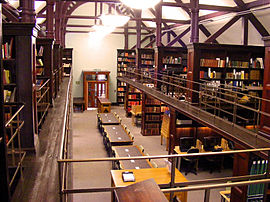- Museum of Wigan Life
-
Coordinates: 53°32′39″N 2°37′47″W / 53.5442°N 2.6297°W
Museum of Wigan Life 
The refurbished Taylor Gallery at the Museum of Wigan Life, previously Wigan's first reference libraryEstablished 1878 (Wigan Public Library)
1990 (The History Shop)
2010 (Museum of Wigan Life)Location Library Street, Wigan, Greater Manchester, England Type Heritage centre Visitor figures 16,000 (April-October 2010)[1] Public transit access Wigan North Western and Wigan Wallgate train stations, Wigan bus station Website www.wlct.org/culture/heritage The Museum of Wigan Life is a public museum and local history resource centre in Wigan, Greater Manchester. Formerly Wigan Library and later the History Shop[2], it is most noted as the library where George Orwell researched his book The Road to Wigan Pier in 1936.[3]
Contents
History
Wigan Public Library (1878–1990)
The building which now houses the Museum of Wigan Life was designed by Alfred Waterhouse and opened in 1878 as the town's first public library. Its construction was funded by local mill owner Thomas Taylor and Dr Joseph Winnard, who each bequeathed £12,000. Dr Winnard's donation paid for the library's books, and portraits of both benefactors remain on display at the museum today. Built on the site of Wigan Grammar School, Wigan Library was opened on 7 May 1878. A Grade II listed building[4], its red brick arches represent the Gothic features which embellish the largely Elizabethan Revival Style chosen by Waterhouse.[2]
Upon its opening, the library comprised two main floors. The ground floor contained an ornate entrance hall, lending library and newsroom, whilst the first floor incorporated a reference library and the Corporation's Public Library Committee meeting room. A third floor, later used for storage and later still as a staff rest-room, accommodated the custodian or caretaker-cum-security officer's flat.
After eight months of discerning book acquisition –nationally renowned specialists were consulted on the selection of new books– the reference library totalled 15,300 volumes and the lending library 6,808. In response to the popularity of the newsroom where current newspapers and periodicals were held, an annexe was built on to the original building in 1892.[5]
The History Shop (1990–2010)
In 1990, due to increasing need for space, Wigan Library was relocated to the New Town Hall, formerly the site of Wigan Mining and Technical College. In 1992, the newly-formed Wigan Heritage Services opened the History Shop in the old library building with the intention of hosting travelling (temporary) and in-house (permanent) exhibitions. Also housed there would be the Wigan Local History collection, parish registers and census returns in a study/research area on the building's first floor.[2]
Initially, the History Shop shared building space with the Wigan Careers Service. When they were forced to move out in 1995, however, an opportunity arose for Wigan Heritage Services to take over the entire building. Funding for this –a total of £260,000– would come from the National Lottery and Monica Whickham, last surviving daughter of Wigan vicar William Whickham.[5] In honour of their donation, the art gallery space situated near the Library Street entrance was renamed the Whickham Gallery.
The Museum of Wigan Life (2010–)
The History Shop was closed in 2009 following the announcement of a £1.6million refurbishment, to be reopened the following year as the Museum of Wigan Life. £500,000 of Heritage Lottery Fund money was matched by Wigan Council and Wigan Leisure and Culture Trust for the building's redevelopment, which saw extensive internal and external restoration. The roof was re-tiled,[6] whilst the ground floor exhibition space was overhauled to focus on aspects of Wigan life and culture. New features included an extra staircase, family study area as well as a revamped reception area, meeting room and shop.[7]
The museum was formally opened by Mayor of Wigan Michael Winstanley on 1 July 2010. In its first six months of operation, the renovated building saw 16,000 visits.[1]
References
- ^ a b "New report criticises lack of arts facilities". Wigantoday.net. 13 October 2010. http://www.wigantoday.net/news/new_report_criticises_lack_of_arts_facilities_1_2032778. Retrieved 2 November 2010.
- ^ a b c "Official Opening of Museum of Wigan Life". Wigan Council. 1 July 2010. http://www.wigan.gov.uk/News/MuseumOfficialOpening.htm. Retrieved 2 November 2010.
- ^ "'Orwell' library to be restored". BBC News. 22 April 2009. http://news.bbc.co.uk/1/hi/england/manchester/8012282.stm. Retrieved 2 November 2010.
- ^ "Museum of Wigan Life". Visit Britain. http://search.visitbritain.com/en-NZ/details.aspx?contentid=157938&industrytype=13&industrysubtype=4,. Retrieved 2 November 2010.
- ^ a b Alastair Gillies. "Wigan's History Shop". Mmu.ac.uk. http://www.mcrh.mmu.ac.uk/pubs/pdf/mrhr_11_museums_gillies.pdf. Retrieved 2 November 2010.
- ^ "History Shop Blog". Wigan Leisure and Culture Trust. 21 December 2009. http://www.wlct.org/culture/heritage/hsblog.htm. Retrieved 2 November 2010.
- ^ "The Museum of Wigan Life reopens after a £1.9 million restoration project.". Culture24.org.uk. 5 May 2010. http://www.culture24.org.uk/history+%26+heritage/art78453. Retrieved 2 November 2010.
External links
Museums and Galleries in Greater Manchester Art Historic house Local history and culture Military and war Imperial War Museum North · Stockport Air Raid SheltersNatural history Science, engineering,
transportationSpecialized See also List of museums in Greater ManchesterCategories:- Museums in Greater Manchester
- Visitor attractions in Wigan
- Buildings and structures completed in 1878
- Grade II listed buildings in Greater Manchester
- Buildings and structures in Wigan
- Local museums in Greater Manchester
- Art museums and galleries in Greater Manchester
Wikimedia Foundation. 2010.
